Author : Barry Tyler
Despite the news of an increase in the number of models at the top end of the range, The Riviera Group has confirmed its commitment to the entry level end of the market also, following the world release at the recent Sanctuary Cove International Boat Show of a state-of –the-art Series Two version of its popular Riviera 3600 Sports Yacht model.
Riviera obviously appreciated this most necessary of niche areas of the cruiser market and as such has re-visited this entry level vessel again, embracing the concept further by enhancing dramatically the ‘family’ aspect, with additional and more user-friendly accommodation provision. The company has seemingly gone to great lengths to provide the consummate allrounder that offers sports performance and handling, improved economy, elegance and practicality.
Aimed unashamedly at the mum and dad retiree market as well as the first time family boater who may have neither the budget nor the inclination to foot it with the big boys, while thankfully Riviera has resisted totally the temptation to mess with the under hull design, or the visually appealing exterior profile (apart from the availability of coloured topsides and the addition of a bonded glass window in the hull side), it has now added the usual marketdemanding cosmetic changes expected in a 2009 model cruiser.
Included within these changes were three ‘biggies’ – a change of power mode, an additional bedroom, and a cockpit floor with a difference. Central to this change and certainly impacting on the above layout changes was the seemingly radical change of powertrain. Shaft drive is out and in for 2009 is the decision to fit this latest model with the IPS (Inboard Propulsion System) pod-drive system which Volvo Penta suggests offers a 20% increase in speed, 15% greater acceleration, up to 50% lower noise and vibration levels, easier handling and 30% better cruising range. Whether or not you fully believe all that hype is up to the individual but one cannot escape the fact that more and more boaters are succumbing to the simplicity and ease of operation of this system; hence the rationale behind Riviera’s decision to offer this model, solely with this power mode.
As well as the suggested performance attributes the other very direct benefits of this power configuration accrue from the compactness of this IPS drive and propulsion system. The greater internal volume provided designers with the opportunity to provide a second family-orientated full-beam aft stateroom, along with a seemingly larger cockpit. Seemingly being the operative word for it was more the fact it was devoid of the cockpit seating and dining provision the earlier model boasted.
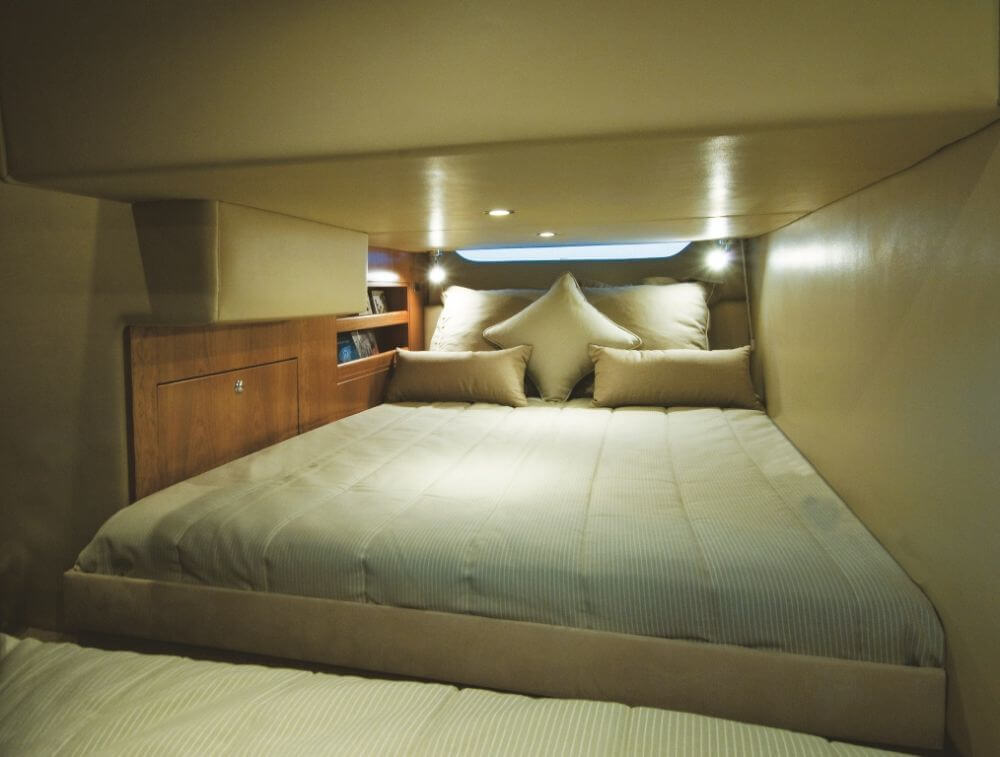
Why, was my first subconscious thought regarding the lack of this perceived ‘vital creature comfort’, but of course yet again the answer lay in the age old reality that everything aboard a vessel is a trade-off in some way, regardless of size or stature of the vessel. The fishermen will love the uncluttered surprisingly generous working area, the entertainers may well be disappointed in some small way, but the reality was this ‘nudity’ (apart from the portside refrigerator and starboard sink and gas-bottle cupboard) in the cockpit was infinitely more sensible in a situation where the trade-off was sublime access to the engines and mechanical peripherals that lay below.
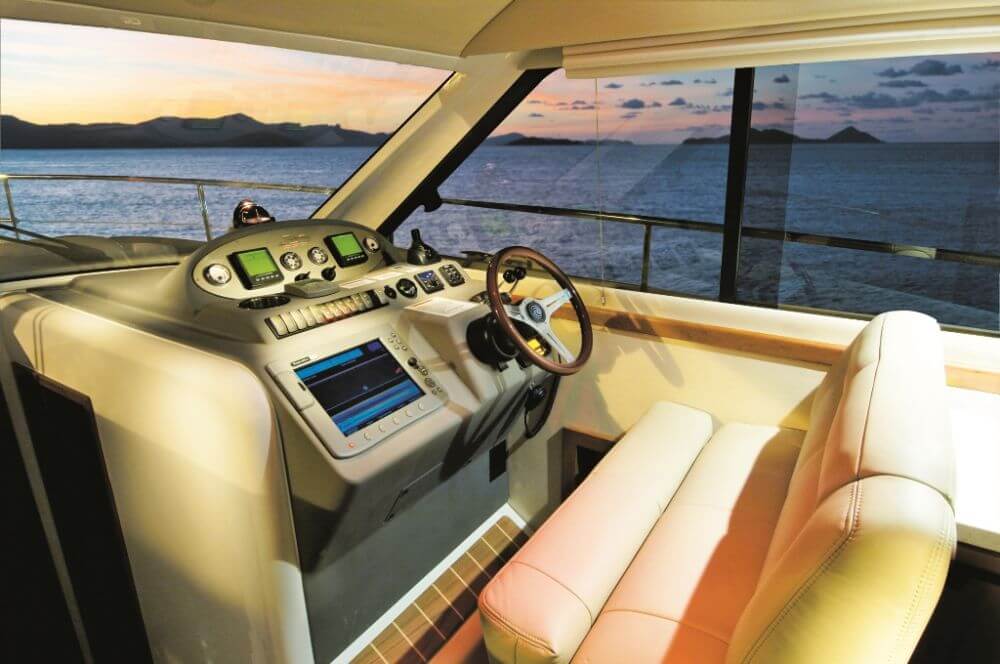
The other ‘compensator’ was the boarding platform that while generous in proportion and safe with its aft pulpit-style frames, offered convenient access to the giant transom ‘boot’ that provided good storage potential for fenders, wet gear, mooring lines – and an outdoors table and chairs setting, for the cockpit! Problem solved, as regards the lifestyle aspect of your cockpit, but if you were still unhappy with that ‘remote arrangement then Riviera does provide an optional lounge and dining table setting appropriate for a lifting cockpit sole.
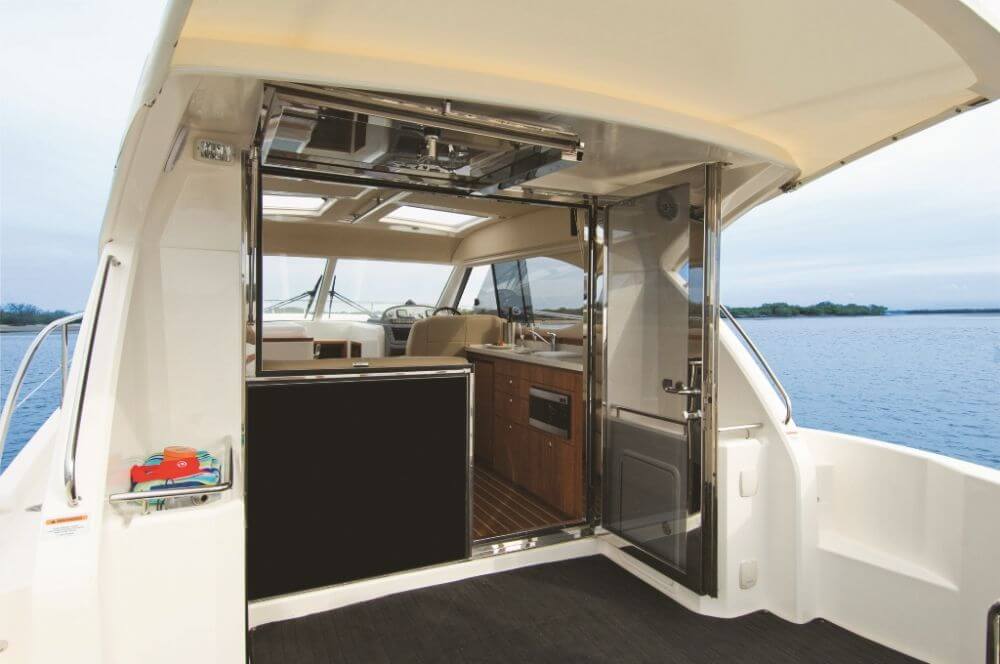
Indoor Outdoor Living
The indoor-outdoor lifestyle aspect of this single-level 3600Series II was embraced with the above features, and of course the usual bow-rail encapsulated expansive foredeck that beckoned the sun-worshippers forward to the sun-pad. But it didn’t stop there, for stepping inside one quickly appreciated the fact this lifestyle theme flowed through to the saloon area as well, courtesy of the lift-up 4400SY-style hopper window which deemed the aft bulkhead pillar-less.
Light, bright and surprisingly very spacious in the context of the ‘baby of the fleet’, ambience was a word that sprang to mind to describe this open-plan saloon which was presented in contrasting American cherry timber, leather upholstery, gelcoat and plush vinyl wall and ceiling panels. But it was the innovation too which caught the eye with the designers combining effectively, practically and compactly, such diverse facets as the galley, the dining area, bar and entertainment facilities and of course the helm station.
The first thing I do when considering the capability of any vessel, is to check out the correlation between accommodation potential – and the galley, dining and ablution provision. The more the accommodation the more ‘accommodating’ the latter three components need to be and I must say I was pleased to see the in house Riviera design team had acted accordingly by providing an ‘appropriate’ self-contained galley to starboard. Features included an electric cook-top, generous bench and cupboard and drawer space, a nice deep sink, a microwave oven and an under-bench refrigerator with freezer compartment.
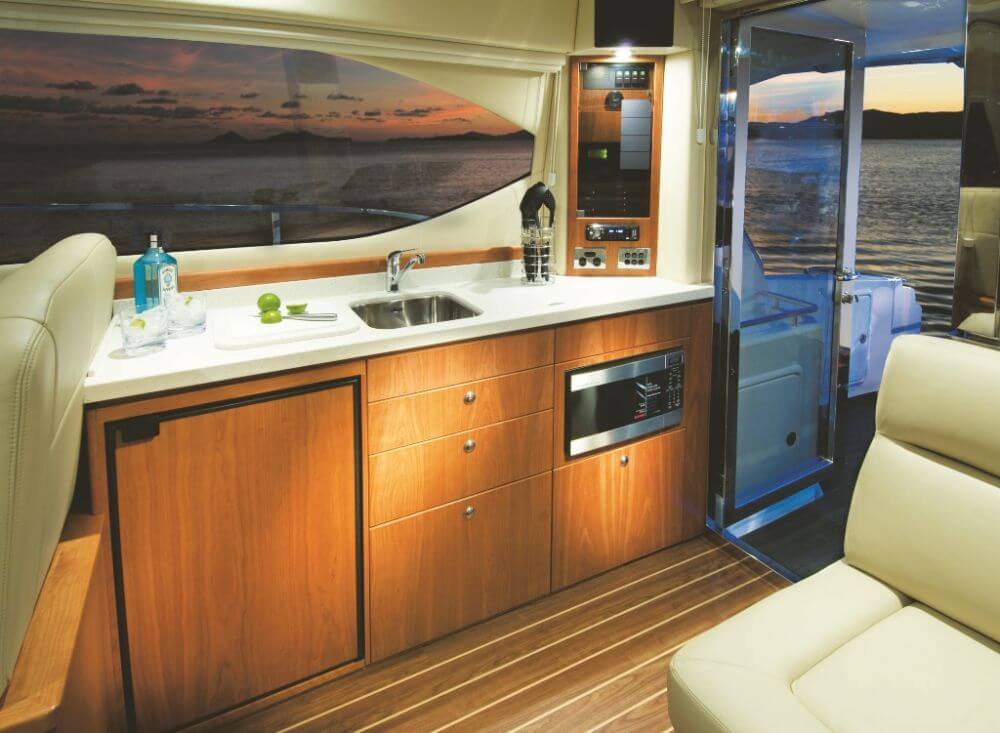
Opposite the galley was an L-shaped full-length leather lounge, crying out in this instance for a dining table that I assume was to be fitted at a later date. Ahead of this was a bulkhead that cleverly, to break this expansive area up, housed the electrically operated rise and fall television.
Opposite this bulkhead of course was the helm station, a decidedly grandiose spectacle in the context of a vessel of this dimension and stature. Particularly impressive was the two-person helm seat, perfect for the ‘mum and dad’ situation, for it was at just the right height and distance from the helm wheel so as to be ergonomically comfortable. Likewise, the electrics, navigational equipment and the Volvo Penta controls were all within easy reach. Especially appreciated were the moulded footrests with teak inlays, which were strategically placed again at just the right height.
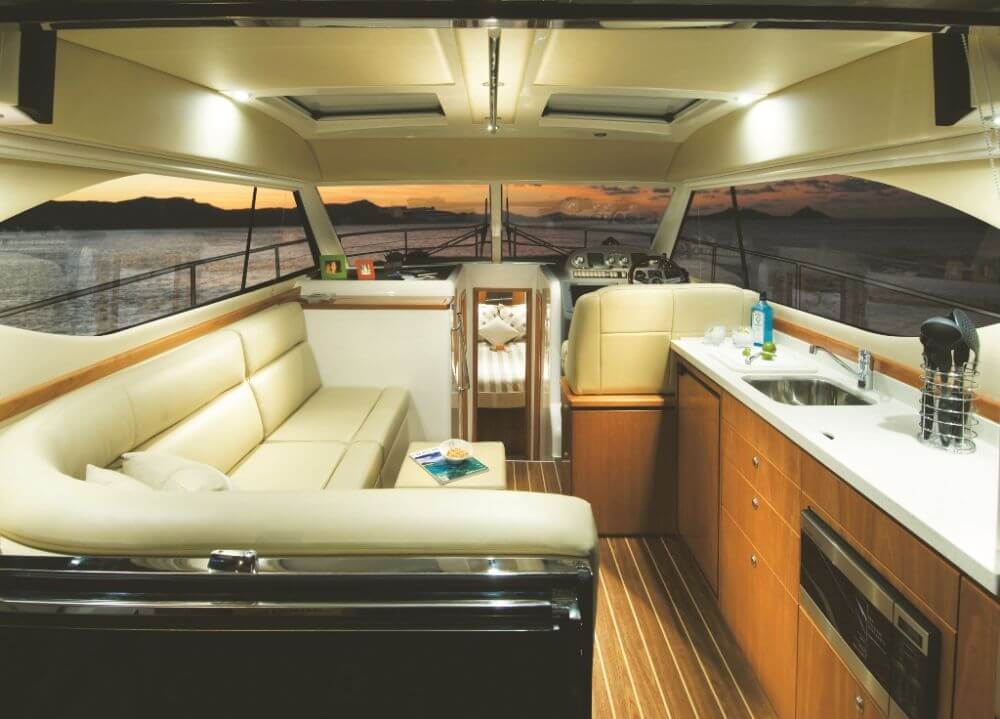
Décor and creature comforts within the saloon really were particularly impressive, akin to what you would expect to find in a much larger cruiser. Sliding side windows and hatches in the opaque overhead sunroofs provided really good ventilation but if that still didn’t suffice the standard issue of 10kW of reverse-cycle Cruisair air-conditioning ensured the saloon and accommodation areas below were kept at an acceptable temperature. Other features in the saloon included a liquor cabinet and bottle and glass storage drawers, and an entertainment package with the aforementioned electric-lift 22-inch LCD TV and an integrated AM/FM stereo, CD and DVD player. A lovely, cosy, ‘warm’ room!
Accommodation
As stated, this Series II version now features a two-cabin, one bathroom accommodation area below decks. The master stateroom was in the bow in this instance, with the island queen berth (complete with inner spring mattress) complemented by the Cherry woodwork, plush panels and features such as storage drawers under the berth, a portside cedar-lined (nothing was forgotten or compromised) hanging locker, pigeon lockers above the bed, an overhead hatch and if you required it, an optional 15” LCD TV and DVD package.
The one bathroom aboard understandably was ambidextrous, with entry both from the master stateroom and from the companionway. Featured here were items such as a solid surface bench-top with a mirrored vanity cabinet above and a storage locker below, a VacuFlush toilet, an overhead hatch and a separate acceptable sized shower cubicle. The real bonus for me (and of course the guests themselves) was the aft stateroom that Riviera was able to incorporate into the design, as stated courtesy of the extra space accrued by installing the Volvo Penta IPS system. Now don’t get me wrong, this privatised cabin was most certainly not of grandiose ball-room proportions; and no, you could not stand upright anywhere but directly in front of the hanging wardrobe and chest of drawers; but nevertheless, this was still a cabin which very capably satisfied the requirements of a typical ‘family’ style of cabin

Aft of this crafted wooden drawer and wardrobe combo was the single fore and aft berth, then alongside and in effect under the cabin sole, was the athwartships double berth. Large hull-side fixed windows provided the natural light while at the same time relieving the potential for claustrophobia, with other features such as wall lighting, storage under the berth, pigeon hole lockers beside the main berth, and a large mirror fitted to the aft bulkhead – added further dimension and style to what was an impressive yes, stateroom.
The Right Credentials
At 11.73m overall and with a generous beam of 3.83m, the 3600 SY Series II boasted Riviera’s typical methodology of a hand-laid GRP hull and a deck and enclosed hardtop structure of a hand-laid composite of GRP and a variety of densities of cores. The displacement figure of 8,900kg suggested to me that the hull was certainly built to last, and certainly that it would be a most rigid and robust structure, an impression that was certainly confirmed when we asked the question of her during the performance part of the test.
Power as we alluded to was a pair of D4, 3.7-litre, inline 4-cylinder 301hp Volvo Penta IPS 400 diesel engines coupled to the IPS pods that ran in this instance the T5 Volvo Penta twin counter-rotating propeller system. For the cynical who raise all the smoke screens in the world as to why you should not use this system, all I can suggest is try one, before you dismiss the idea, for they offer a whole new dimension of handling and manoeuvring – at the flick of a joy-stick and the turn of a wheel.

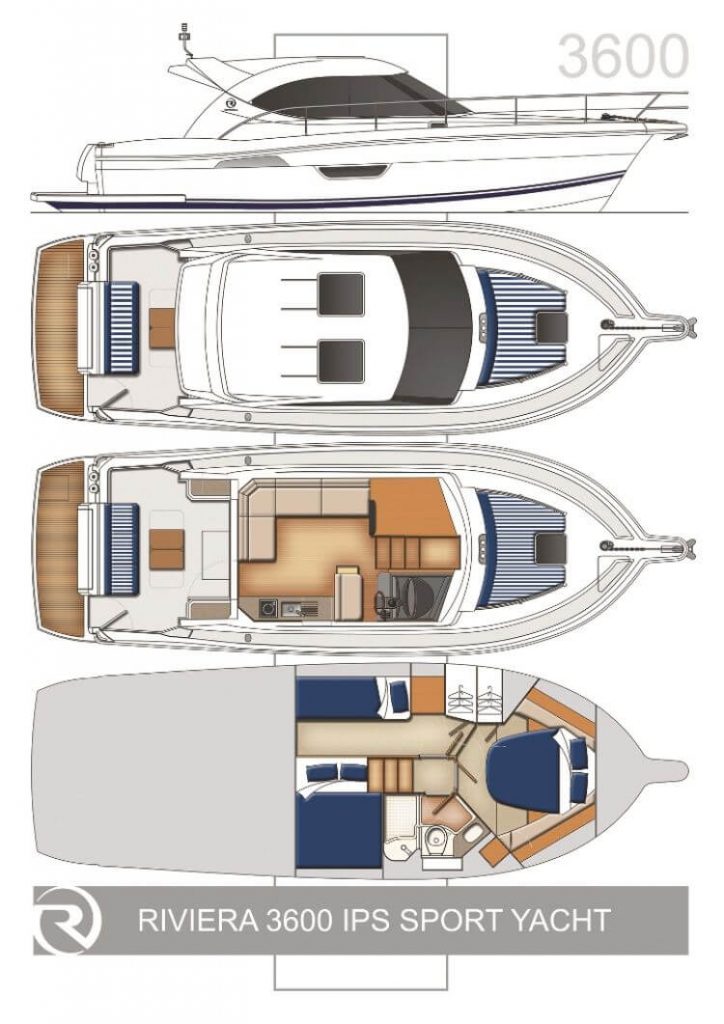
With the IPS system being so very compact, the net result was the engine room also became the ‘mechanical peripherals’ room for there was a sublime amount of space still available for items such as the 800 litres of fuel, the 390 litres of water, the four 200Ah AC Delco batteries which were housed incidentally in special battery boxes in accordance with ABYC (American Boating and Yacht Council) standards, the 12V/60A Victron charger and 750W inverter, the Cruisair reverse cycle air-conditioning system and of course the obligatory ‘Sea Fire’ fire-prevention system.
Conclusion
Interestingly, this was the first time I had experienced the 301hp Volvo IPS versions and I have to say the performance attributes were near on identical to those of the 3600SY’s older brother, the 4400SY which ran the larger 435hp IPS600 versions. The acceleration out of the hole was sublime, the top speed of 31 knots was most impressive, but what won me over was the economical cruise speed of a whopping 29 knots. The 3600Series II Sports Yacht is undeniably the baby of the Riviera fleet but it lacked nothing in terms of finish, presentation, specification and most importantly, performance, handling and efficiency. As far as value for money goes, your money goes a long way; base price for the 3600SY is $519,000 and with the options which included, the coloured topsides, BBQ, the air conditioning split to the aft cabin, the rear awning, the Roman blinds and soft furnishings package and the Raymarine E120 electronics package – the as-tested price of $552,378 must be considered great value for money on today’s market.
TECHNICAL SPECIFICATIONS
- Design Name: Riviera 3600 Sport Yacht Series II
- Year Launched: 2009
- Designer: Riviera
- Interior Designer: Riviera
- Builder: Riviera
- LOA: 11.73m
- Beam: 3.83m
- LWL: 9.456m
- Draft: 1.06m
- Displacement: 8,900kg
- Max Speed: 31 knots
- Cruise Speed: 29 knots
- Construction: GRP
- Fuel Cap: 800 litres
- Water Cap: 390 litres
- Engines Make: 2 x 301mhp Volvo Penta 400 IPS




